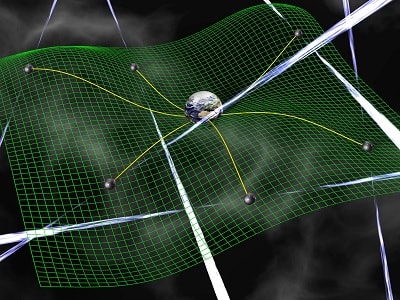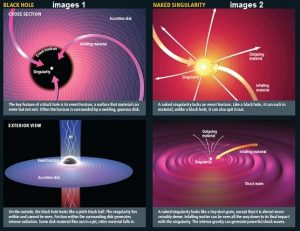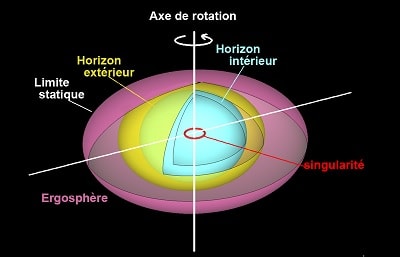Differentiate Black Holes and Naked Singularities With Pulsars
For several years, pulsars are used extremely powerful detection tools for physicists. Indeed, thanks to the high stability of their rotation period and so their pulsation frequency, pulsars have allowed to observe several major Astrophysical events, either in terms of theoretical physics or Planetology.
The interest of researchers including fell, in recent years, on the study of pulsars in the vicinity of compact objects like black holes. Thus, the discovery of the pulsar RMS J174-2900 near the super massive black hole SgrA, located in the center of the milky way, gave the opportunity to the various telescopes rays X/rays gamma/radio to study the behavior of the pulsar in an environment gravitational extremely intense.

The interest to study these systems pulsar-black hole is two-fold . First of all, by studying the regularity of the pulsar rotation and its potential variations, physicists can simultaneously study the properties of the black hole. Then, observe the behavior of the pulsar immersed in an important gravitational field also allows to directly test some parameters of general relativity.
But the role of pulsars in such systems does not stop there. Indeed, their study could also provide information on the presence or not of a horizon of events around the compact object. This is the assumption that propose an Indian team of physicists in a publication on arXiv November 11, 2017.
Naked singularities and black holes
The authors show that the frequency of issuance of a pulsar can be changed near a compact object in rotation as a black hole of a naked singularity or Kerr (black hole in rotation). The difference between these two objects to the presence or not of an event horizon.
In the context of general relativity, the Kerr black hole is a solution to the equations of the gravitational field, based on the Kerr metric. It's a black hole described by three parameters: a positive ground, a moment kinetics (amount of rotation) nonzero and one charge electric zero. In Astrophysics, black holes 'realistic' being known in rotation and electrical load zero or negligible, Kerr black hole is probably the 'real' type of black hole existing in nature.
Another solution based on the Kerr metric exists and is different from the black hole. Called 'space-fast Kerr time', this solution admits a space-time in high-speed rotation, without event, which is a gravitational Singularity horizon horizon without rotating. Such a singularity is named «naked Singularity»

Contrary to conventional wisdom, in general relativity, is not the gravitational singularity that defines a hole black but rather the presence of an event horizon. All types of black holes have an event horizon; This common feature is the unique setting of a black hole. Therefore, a black hole differs naturally a naked singularity.
If the naked singularity is a solution to the Einstein equations, his physical 'reality' is still debated. The mathematician Roger Penrose is the first to reject the existence of naked singularities guessing at the principle of "cosmic censorship". According to this, no singularity can be formed outside a horizon of events because in such a case, space-time would be unpredictable effects. Then, in 1986, the Canadian cosmologist Werner Israel has demonstrated that if the rotation of a black hole reached its maximum frequency, so its angular momentum slows down, preventing the formation of a rapid Kerr space-time.
Derivative of a horizon of events through the pulsars
In their study, physicists propose to use pulsars to discriminate the type of compact object around which they orbit: black hole or naked singularity. This discrimination passes by the highlight or not a horizon of events around the object. Indeed, according to the type of object, the dynamics of the pulsar won't be the same.
First of all, the first parameter to be considered is the rotation period of the pulsar. In the vicinity of a compact object in rotation, the rotation period of the pulsar will be changed because of the gravitational effects extremely intense. This change will result in a variation of the frequency of pulse measured on Earth.
Around black holes in rotation, rotation is so intense that space and matter are drawn into its movement; This movement of training is the Lense-Thirring effect name. The area in which it occurs is called 'the ergosphere. It is this movement that is originally from the alteration of the rotation period of the pulsar.

However, the form of the ergosphere is different depending on whether it is a black hole or a naked singularity. As a result, the rotation period will not be affected in the same way. In the vicinity of a black hole, the frequency of pulsar emission drastically increases with distance from the event horizon. More it gets closer, more frequent. So, the detection of extremely high frequency - superior at 716 Hz (5) - would indicate the presence of a horizon.
In the case of a naked singularity, the pulsar rotation rate increases also depending on the distance to the singularity, but a much less significant. This is partly due to the effects of gravitational tides that impact the structure of the pulsar, before than its frequency becomes too high.
Then, the second parameter to be considered is the future of the pulsar. In the case of a supermassive black hole, the tidal forces are strong enough to dislocate the pulsar. On the other hand, in approaching the event horizon, its frequency of rotation becomes such that he would eventually break up as a result of this extreme rotation. The authors give the name of 'phenomenon of dislocation by increase of the precession of the spin' to this scenario (SPDC).
In contrast, in the case of the naked singularity, the tidal forces are sufficiently violent to dislocate the pulsar. Indeed, no horizon not located between the source of the gravitational field (the singularity) and its periphery, the gravitational intensity is maximum in the vicinity of the singularity.
Both of these scenarios have unique signatures. For a dislocation due to the forces of gravitational tides near the naked singularity, a powerful electromagnetic radiation would be issued and picked up on Earth. While for a SPDC, the pulsar would be close enough to the black hole for the event horizon absorbs most of the radiation, leaving that a tiny fraction arrive on Earth.
Obviously, this theoretical model is quite speculative and requires recesses. One of the ways to improve the model is to explore the trail of the gravitational waves emitted in these scenarios. If the properties of the gravitational waves vary based on a dislocation by effects of tide or a SPDC, their study would also differentiate a black hole of a naked singularity.









Post a Comment